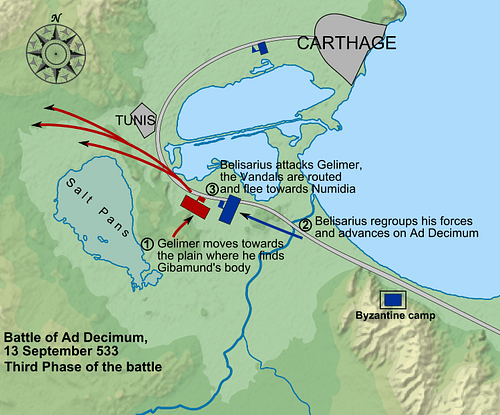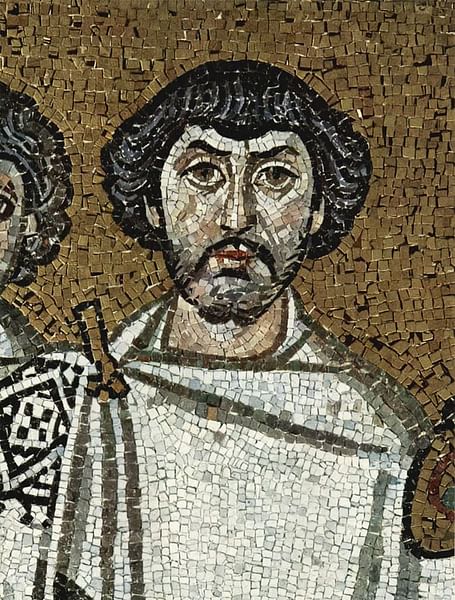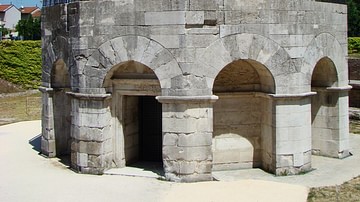The Battle of Ad Decimum near Carthage, North Africa took place in September 533 CE and was the first major battle of the Vandalic War (533 - 534 CE) between the forces of the Byzantine Empire and the Vandal Kingdom. Leading the Vandals was the newly crowned king Gelimer (480-550 CE) who had usurped Hilderic (r. 530-534 CE). Then on the side of the Romans was the rising star of the Byzantine military, Belisarius (c. 500-565 CE). This battle would be the definitive start of Justinian I's (r. 527-565 CE) wars of reconquest. These wars were fought with the ultimate goal of reuniting the former provinces of the Western Roman Empire with the Byzantine Empire.

PROLOGUE
The Battle of Ad Decimum has its roots in the expansionist policies of the Byzantine Emperor Justinian I and his goal of reconquering the former provinces of the Western Roman Empire, thus bringing them back into the Roman fold of what was the Eastern Roman Empire. The Vandals had been occupying the former Roman province of North Africa for nearly 100 years with two notable military achievements to their name. These achievements were the sacking of Rome in 455 CE and the defeat of a large Byzantine invasion fleet in 468 CE. A fleet with the same mission Belisarius would find himself with a number of years later. Justinian I, having secured an “eternal peace” with the Sassanid Empire, looked westward towards the reconquest of the former Western Roman Empire and first considered the retaking of North Africa. All Justinian needed was a reason to involve himself in Vandal affairs and the coup led by Gelimer against the pro-Roman Vandal king Hilderic in 530 CE provided it.
THE BATTLE
Belisarius and his army would leave Constantinople in June of 533 CE on ships of the Byzantine Navy. The Roman invasion force would sail firstly towards the island of Sicily to conduct a reconnaissance of the land for future military operations and then land south of Carthage at the city of Caput Vada. This decision was not made without good cause. As the expeditionary force neared the African coast Belisarius and his generals held a council to discuss the pending invasion. Several of the Byzantine generals advocated for a landing directly at Carthage to catch the Vandals unawares and put them at a disadvantage. However, Belisarius argued that such a landing would place the Byzantine fleet within the realm of the Vandalic Navy's area of operation. Such a naval engagement between the much smaller Byzantine navy, whose men would be fatigued and seasick, and the larger, rested Vandalic navy would almost inevitably lead to a Byzantine defeat and the end of the expedition. Such an end would be highly reminiscent of the failed invasion in 468 CE. Using this argument, Belisarius made the decision to minimize the risk to his army and so the fleet avoided Carthage. Following the landing of his army, Belisarius would lead them into combat at Ad Decimum, the land battle taking place approximately 16 km (10 miles) south of the city of Carthage.
On the side of the Vandals was the newly crowned Vandal King Gelimer. Gelimer planned to end the Byzantine invasion in one decisive engagement. His hopes were to trap the Byzantine invasion force along the coast at Ad Decimum by coordinating three separate forces to block the front of the Byzantine army while simultaneously attacking the rear and flank. He planned to use the geography around Ad Decimum to trap and cluster the Byzantine army. However, lacking a sophisticated command and control structure, such synchronization proved impossible for the Vandal military. The lack of synchronization would utlimately lead to Gelimer's downfall during this battle.
The Vandal blocking force left from Carthage early and with poor organization - the Vandals moving out from Carthage in small bands and with no real coordination. During their movement towards Ad Decimum the lead Vandal element, led by Gelimer's brother, came in contact with the lead Byzantine element under the command of one of Belisarius's trusted subordinate commanders John the Armenian. John and his advance force smashed into the Vandal vanguard, killed Gelimer's brother, and began to systematically destroy the small groups of Vandal soldiers' piece by piece all the way back to the city of Carthage.
A very similar story unfolded along Belisarius's left flank, his right being guarded by the sea and the Byzantine Navy, where a group of Hunnish mercenaries under the employ of the Byzantines met with and destroyed the Vandal force whose mission was to attack Belisarius on that flank. The Vandals were so terrified at the sight and reputation of the Huns that they were reportedly shocked and immediately demoralized.
Belisarius, in his never-ending quest for battlefield intelligence, had scouts screen the rear and sides of his army. These scouts would allow Belisarius to detect the main Vandal army under Gelimer that was trailing him to his rear. This was an important piece of information because reliable intelligence on enemy movements, as so often in battle, proved a huge determining factor in a generals' battlefield success. The intelligence would lead Belisarius to encamp his infantry in a fortified location in order to secure his rear against Gelimer's army while simultaneously freeing his cavalry to maneuver at will with no regard for protecting the infantry.
The final engagement at the battle of Ad Decimum was between Belisarius himself and Gelimer and the main Vandal army. Gelimer, having taken an inland road to beat Belisarius to Ad Decimum, for some unknown reason, happened upon the Huns who had just eliminated his flanking force. Gelimer and his army retook the hill and routed the Huns. However, upon taking the hill Gelimer would discover the body of his dead cousin and brother. This caused Gelimer to be distraught and neglect the command of his soldiers. Belisarius rallied what remained of the Huns and took his cavalry on a charge against the numerically superior Vandalic army atop the hill. This charge, coupled with the disorganization provided by Gelimer's emotional instability, caught the Vandals unprepared and off guard. Belisarius was able to drive the Vandals from Ad Decimum and thus secured himself an important victory and a secure route to Carthage.
The Aftermath
After the rout of Gelimer in the North African desert, there would be one other major battle of the Vandalic War at Tricamarum in December 533 CE where Gelimer once more succumbed to defeat. Immediately following the battle Belisarius would spend some time reorganizing and reconsolidating his forces before his entry into the city of Carthage. The Byzantine army peacefully occupied the city under the orders of Belisarius. Following the occupation of Carthage, the Byzantines would rebuild the city and eventually venture out to attack the Vandals at Tricamarum. This second victory in favor of Belisarius and the Byzantines secured the reunification of the African province into the Byzantine Empire. After this, the province would go on to become one of the most stable in the entire Byzantine Empire. Meanwhile, Gelimer was shipped off to Constantinople in chains to be presented in a Roman Triumph. Belisarius would continue his campaigns of reconquest in Sicily and Italy, only having to return to Africa once to subdue a revolt led by disgruntled Byzantine military commanders.












